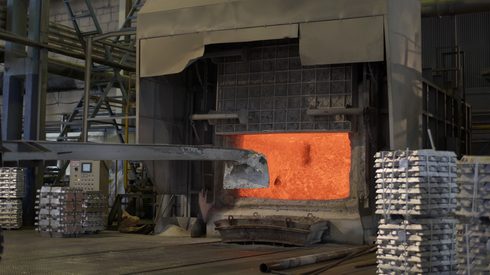Aluminium price on China’s economy
Range-trading has characterized the LME aluminium price as the decline since the start of October attempts to stabilize. At the beginning of the year, market participants had overestimated China’s ability to stimulate its way out of the Covid-lockdown era, putting too much emphasis on a fast and robust recovery. However, as China’s economic performance disappointed, optimism turned into pessimism, leading to a decline in base metal prices. We believe the market is now underestimating China’s eagerness to implement growth-supportive policies, which could result in a scramble to catch up if China’s economy starts to regain strength.
This sentiment aligns with our belief that there will be a gradual stabilization in the latter months of the year.
We expect a more favorable macroeconomic environment for the base metals market as China’s economic recovery accelerates. Seasonal price factors, especially during the fourth quarter, could also influence positively.
LME aluminium prices has pulled back since its October high at $2,367 per tonne. While we anticipate a little bit more downside pressure, we believe that these lower values will continue to attract dip buyers. But, we need to see more evidence of follow-through buying from here on to justify our positive year-end outlook. Learn more.
Copper prices a mixed picture
Global copper mine production has risen modestly by 1.3% during the first eight months of 2023 despite challenges in significant mining regions like Chile, China, Indonesia, Panama, and the United States. Unforeseen weather patterns and disruptions have impacted output, leading to a significant downturn in production volumes. For the full year, we anticipate a 0.8% overall growth in mine production, assuming unplanned disruptions continue to affect operations in the final quarter.
Refined copper production globally has shown a positive trend, increasing by around 5% this year. China has been a key driver, with a remarkable 12% surge in refined production. However, challenges continue with declines in regions like Chile and the United States, highlighting disparities in global refined copper production due to operational challenges. Demand for refined copper has varied worldwide, with an overall increase of 2.5% in consumption. China remains the primary driver, with a substantial 7.0% rise in consumption, solidifying its position in the global copper market.
Copper prices face challenges from market sentiment, momentum, and positioning. However, a tactical rebound seems plausible, driven by China’s revitalized economic momentum and sustained policy support. We await clearer technical confirmations before being more confident in our view. The risk associated with bearish positions at the current price point seems unattractive. A clearer indication of a US economic recession would be required to validate a bearish stance, which the existing data does not substantiate. Learn more.
Zinc market surplus, China’s demand
The International Lead and Zinc Study Group (ILZSG) reported a surplus of 21,900 tonnes in the global refined zinc market for August, increasing from a revised 2,900-tonne surplus in July. The cumulative surplus for the year’s first eight months stood at 489,400 tonnes.
World metal stocks grew by 109,700 tonnes from January to August, while LME and SHFE stocks combined only increased by 62,491 tonnes year-to-date. The stock data suggests metal moving into warehouse finance deals rather than the open market.
In China, January to August saw a 3% year-on-year growth, but macro uncertainties pose challenges elsewhere as zinc demand ex-China contracted by 2.5% during the same period. ‘Apparent’ zinc consumption in China is estimated to increase by only 0.5% year-on-year in September, while indicators show respectable ‘real’ demand, including:
- White goods production, such as washing machines (+24.2%) and refrigerators (+13.2%), continue to display solid year-on-year growth.
- Vehicle production has also increased by 7.3% in the first nine months.
The zinc concentrate market is tightening, with falling spot TCs. However, the transition into the refined market will take time, and with around 1 million tonnes of mine capacity scheduled to start operations next year, further refined oversupply is predicted for 2024. Without greater smelter discipline, zinc price gains are expected to be limited to bear-market rallies. Learn more.
Tin prices decline on reduced consumption
In late October, tin prices on the London Metal Exchange experienced a significant decline, dropping by 2.4%. This was the weakest performance among base metals. Despite China’s better-than-expected GDP in Q3 and a weaker US dollar, negative sentiment dominated global risk appetite last week, limiting any potential recovery in tin and other industrial metals.
We expect tin consumption to decrease by around 1.6% to 371,000 tonnes in 2023. This downward trend follows a recalibration from the pandemic recovery bounce in 2021 and is influenced by macroeconomic challenges like inflation. However, technological innovations in sectors such as renewable energy and electric vehicles (EVs) partially offset these declines, reflecting a nuanced demand landscape for tin in 2023. Various sectors exhibit differentiated performance trajectories for tin usage, including:
- The solder sector, which makes up the largest portion of global tin consumption, is projected to remain relatively stable with a subtle growth of 0.4%.
- The integration of tin in technology applications like solar panels and EVs plays a crucial role in maintaining this stability. Notably, the use of tin in solar ribbon production, accounting for approximately 12% of the solder sector, drives significant innovation-driven demand.
- The chemical sector is expected to experience a decline in tin usage by 4.9%, reflecting the ongoing impacts of the global pandemic and broader economic downturn.
- Additionally, the tinplate sector is set to decline by 4.2%, primarily due to macroeconomic challenges and suboptimal food harvests.
Our stance on the tin price forecast remains steady: Despite the possibility of near-term market fluctuations due to unfavorable macroeconomic conditions, we anticipate a more optimistic outlook as we move deeper into the fourth quarter. We foresee market participants giving more weight to China’s economic resurgence, which may lead to some short-covering as the year concludes. Learn more.
To understand the complex market conditions influencing price volatility, download our monthly base metals price forecast, including the latest copper price forecasts today. Get a free sample.






